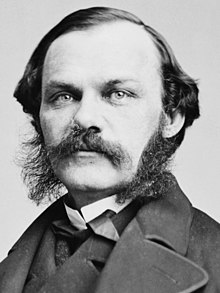Our website is made possible by displaying online advertisements to our visitors.
Please consider supporting us by disabling your ad blocker.
Henry Jarvis Raymond
Henry Jarvis Raymond | |
|---|---|
 | |
| Member of the U.S. House of Representatives from New York's 6th district | |
| In office March 4, 1865 – March 3, 1867 | |
| Preceded by | Elijah Ward |
| Succeeded by | Thomas E. Stewart |
| 2nd Chairman of the Republican National Committee | |
| In office 1864–1866 | |
| Preceded by | Edwin D. Morgan |
| Succeeded by | Marcus Lawrence Ward |
| Lieutenant Governor of New York | |
| In office 1855–1856 | |
| Governor | Myron H. Clark |
| Preceded by | Sanford E. Church |
| Succeeded by | Henry R. Selden |
| Member of the New York State Assembly from the 7th New York County district | |
| In office January 1, 1850 – December 31, 1851 | |
| Preceded by | Abraham Van Orden |
| Succeeded by | Freeborn G. Luckey |
| Personal details | |
| Born | January 24, 1820 Livingston County, New York |
| Died | June 18, 1869 (aged 49) New York City, New York |
| Political party | Republican |
| Spouse | Juliette Weaver |
| Children | Edward Henry Raymond Mary Elizabeth Raymond Lucy Margaret Raymond Henry Warren Raymond Walter Jarvis Raymond Aimee Juliette Arteniese Raymond Arthur William Raymond |
| Parent(s) | Jarvis Raymond Lavinia Brockway |
| Alma mater | Genesee Wesleyan Seminary University of Vermont Columbia Law School |
| Occupation | Writer, Editor, Politician, Publisher and Founder of The New York Times |
Henry Jarvis Raymond (January 24, 1820 – June 18, 1869) was an American journalist, newspaper publisher, and politician who co-founded both the Republican Party and The New York Times.
He was a member of the New York State Assembly, the lieutenant governor of New York, Chairman of the Republican National Committee, and elected to the US House of Representatives. For his contribution towards the formation of the Republican Party,[1] Raymond has sometimes been called the "godfather of the Republican Party".
- ^ One or more of the preceding sentences incorporates text from a publication now in the public domain: Chisholm, Hugh, ed. (1911). "Raymond, Henry Jarvis". Encyclopædia Britannica. Vol. 22 (11th ed.). Cambridge University Press. p. 933.
Previous Page Next Page


